One Size Does Not Fit All
Multiculturalism, Assimilationism, and Identity Among Majority and Minority Groups in Two New-Established Democracies
Abstract
Abstract. This study compared attitudes toward multiculturalism and assimilationism among three ethnic groups (Serbs, Croats, and Hungarians) in two neighboring countries (Croatia and Serbia). Additionally, this study examined the predictive role of ethnic identity on aforementioned attitudes directly and indirectly via symbolic threat. The results showed that Croats and Serbs had less positive multicultural and more positive assimilationist attitudes when in a majority position than when in a minority position. Hungarians, a minority in both countries, did not differ between countries. Additionally, symbolic threat mediated the relationship between ethnic identification and both assimilation and multiculturalism only in Croatia. The group status moderated these effects. Our findings confirm the importance of group's status and national context in understanding the majority–minority intergroup dynamic.
Identity-conscious and identity-blind ideologies describe attitudes toward different public policies aimed to manage cultural and ethnic diversity in a particular country (Leslie et al., 2020). The most elaborated identity-conscious ideology – multiculturalism – emphasizes recognition and appreciation of different cultures living together (e.g., Leslie et al., 2020; Verkuyten, 2006, 2011). On the contrary, assimilationism as identity-blind ideology emphasizes a demand for minority groups to adopt the dominant culture and abandon their own (Moghaddam et al., 1993; Pelletier-Dumas et al., 2017). In this article, we focus on multiculturalism and assimilationism as the most relevant ideologies for our research context.
The Role of Group Status and Social Context in Attitudes Toward Multiculturalism and Assimilationism
While multiculturalism offers a possibility for minorities to retain their culture and identity, it can be seen as a threat to the identity of the majority group (Correll et al., 2008; van Oudenhoven et al., 1998; Verkuyten, 2006; Zárate & Shaw, 2010). Contrary, assimilationism validates the identity of the majority group (Verkuyten, 2011), but neglects identities of minorities. Accordingly, numerous studies have shown that majorities generally hold more positive attitudes toward assimilationism and less positive attitudes toward multiculturalism than minorities (e.g,. Čorkalo Biruški et al., 2020; Verkuyten, 2005).
These findings are in line with social identity theory (Tajfel & Turner, 1986), which assumes that people want to protect and maintain the positive identity of their group. Therefore, attitudes toward multiculturalism and assimilationism should vary depending on the status that particular ethnic group has in a given context, but very few studies have directly tested this hypothesis (Verkuyten & Yildiz, 2006). Verkuyten and Yildiz (2006) analyzed attitudes toward minority rights of the same ethnic groups (Turks and Kurds) with different status in two national contexts (the Netherlands and Turkey). Using national context framing, they showed that Turks supported minority rights more in the Dutch context, than in the Turkish context, where they are a majority. Interestingly, Kurds (minority in both countries) endorsed minority rights more in Turkish than in Dutch context. These results verify the importance of group status in the endorsement of minority rights but also point out the importance of national context specifics (Verkuyten & Yildiz, 2006). Similarly, a study conducted among students in two universities with different racial compositions (predominantly African American vs. predominantly Caucasian) showed that both racial groups preferred pluralism more when in minority than in majority position in a particular university (Hehman et al., 2012). Additionally, although majority–minority asymmetry in their attitudes toward nation-state and its policies is well-documented, it has also been shown quite convincingly that the national context could not be left out in this equation (Staerklé et al., 2010).
The presence or absence of majority–minority conflict is another important contextual characteristic, which can make intergroup comparisons more salient and ingroup identification stronger (Tajfel & Turner, 1986). Moreover, as showed by Verkuyten and Yildiz (2006), it can be expected that in contexts with more recent intergroup conflict minorities will endorse assimilationism less and multiculturalism more than minorities with no conflict experience.
Additionally, the duration of the minority status, i.e., how long a specific group has been recognized officially as a minority in a particular country, can also be related to diversity policies attitudes. It seems that later immigrant generations and long-established minorities have similar group attitudes to those of majorities (Abouguendia & Noels, 2001; Schiefer, 2013), presumably including attitudes toward multiculturalism and assimilationism.
Building on previous studies, we tested the difference in attitudes toward multiculturalism and assimilationism among three different ethnic groups in real multiethnic social contexts in Serbia and Croatia. Specifically, this study was conducted in circumstances of a reverse majority–minority position of two ethnic groups in two countries where the same ethnic group is the titular nation in one country (Serbs in Serbia and Croats in Croatia) but also a new minority in the other, neighboring country (Serbs in Croatia and Croats in Serbia). Furthermore, another ethnic group (Hungarians) is a long-established minority in both countries. Hence, this study allows for a three-fold comparison:
- 1.Comparison of the same ethnic group when in majority and minority positions;
- 2.Comparison of different minority groups within the same country; and
- 3.Comparison of the same minority group in different countries acknowledging the importance of contextual characteristics when studying majority–minority dynamics (Jelić et al., 2014; Verkuyten & Yildiz, 2006).
Finally, the majority–minority dynamics are either burdened with the legacy of the 1991–1995 war (Croato–Serbian and Serbo–Croatian relations) or conflict from the past is no longer relevant for the current majority–minority relations (Croato–Hungarian and Serbo–Hungarian relations).
The Role of Ingroup Identification and Intergroup Threat in Attitudes Toward Multiculturalism and Assimilationism
Stronger ingroup identification and higher intergroup threat are associated with stronger endorsement of assimilationism and weaker endorsement of multiculturalism for the majority, while the opposite holds for minority groups (Arends-Tóth & van de Vijver, 2003; Berry & Kalin, 1995; Callens et al., 2019; Verkuyten & Martinovic, 2006; Verkuyten & Thijs, 2002). Furthermore, ingroup identification is positively associated with the perceived intergroup threat, especially when the sense of identification is insecure (e.g., Verkuyten et al., 2022). The more individuals prefer the ingroup, the more sensitive they are to any injustice to their group (Riek et al., 2006). Accordingly, support for different intergroup ideologies is susceptible to intergroup threat (Rattan & Ambady, 2013; Schalk-Soekar & van de Vijver, 2008; Sirlopú & Van Oudenhoven, 2013; Tip et al., 2012; Ward & Masgoret, 2006), especially when ingroup identity is salient (Verkuyten & Martinovic, 2006). In sum, we expect that higher ingroup identification will lead to higher perceived threat, which then results in higher endorsement of assimilationism for the majorities and higher endorsement of multiculturalism for the minorities. This premise has been proposed in the group identity lens model (GILM) suggesting that “group identity functions as a group lens that makes people sensitive to anything that concerns or could harm their groups” (Verkuyten, 2009, p. 33).
As suggested in intergroup threat theory, individuals can perceive a realistic threat to a group’s scarce resources and economy but also a symbolic threat to the group's values, culture, and worldviews (Stephan et al., 2009). In endorsing multiculturalism or assimilationism, culture and identity are at the core of the debate, making the perception of symbolic threat especially relevant.
This process is particularly relevant in Serbia and especially Croatia where historical disruptions in 1990s caused substantial changes in group status of two ethnic groups: From being constituent nationality in the common state of former Yugoslavia, Serbs in Croatia and Croats in Serbia became minorities after dissolution of former Yugoslavia. The current situation in Serbia and Croatia makes symbolic threats especially relevant, and religious, cultural, and language differences are still hotly debated (Löw Stanić, 2014).
Therefore, in this article, we look at the interplay between ingroup identification, perception of symbolic threat, and support for multiculturalism and assimilationism in the majority and minority groups in Croatia and Serbia.
The present research examines multiculturalism and assimilationism in recently established democracies of Croatia and Serbia where legacy of recent conflict still influences majority–minority dynamics. Data were collected among adolescents in multiethnic contexts where the schooling is organized in either majority or minority schools and in different, either majority or minority language. This schooling system is making the majority–minority division even more salient from an early age and issues of minority rights, especially for Croats in Serbia and Serbs in Croatia additionally contested (Čorkalo Biruški & Ajduković, 2007). Finally, this study focuses on traditional minorities rather than immigrants that most research focused on. Namely, when two (or more) ethnic groups share the same territory for centuries, the status of minority groups is not quite the same as with newcomers. Such traditional, i.e., national minorities can legitimately claim minority rights as pointed out by some scholars (Kymlicka, 1995), and they usually exercise a set of those that are regulated with different laws and state policies that grant them a sort of special status within society, which is not the case with newly arrived immigrants. Therefore, for traditional minorities, diversity-managing ideologies may be of special importance.
Social Context of this Study
Croatia is ethnically a homogenous country with 90.4% of Croats. However, some parts of the country are highly multiethnic. The present research site located in the eastern counties of Vukovar-Sirmium and Osijek-Baranja represents the most ethnically diverse multiethnic regions in Croatia. In Vukovar-Sirmium County, there are slightly less than 80% of Croats and Serbs are the largest minority (15.5%). In Osijek-Baranja County, there are slightly less than 86% of Croats and the rest are different minorities, with Serbs (7.76%) and Hungarians (2.7%) being the largest. However, in both counties, there are cities where the proportion of minorities goes up to 33% (e.g., the city of Vukovar) or even higher in small villages where minority at the national level is majority on the micro level, e.g., the village of Korog with more than 80% of Hungarians.
Serbia is ethnically also homogeneous, with more than 83% of Serbs. However, the Autonomous Province of Vojvodina, bordering Croatia, is much more heterogeneous, with 67% of Serbs, 13% of Hungarians, nearly 2.5% of Croats, and the rest is an amalgam of other ethnic minorities.
Both Croatia and Serbia became independent states after the dissolution of the former Yugoslavia. Their mutual relations are burdened with the 1991–1995 war, and the social status of Croatian minority in Serbia and Serbian minority in Croatia is highly dependent on the development of relations between these two formerly belligerent countries. Both of them have had a long tradition of granting minority rights (e.g., schooling in minority language) to quite a few ethnic groups living on their territories for centuries as traditional ethnic minorities. However, Croats in Serbia and Serbs in Croatia are so-called new minorities (Mesić & Baranović, 2005), and the issue of minority rights is highly contested in both countries.
Hypotheses
See Figures 1 and 2 for graphic presentations of hypotheses. To test the relationship between group status and attitudes toward multiculturalism and assimilationism, we hypothesized that
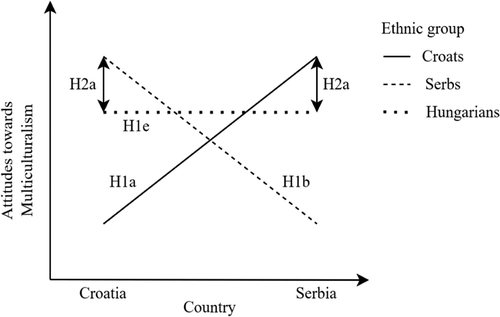
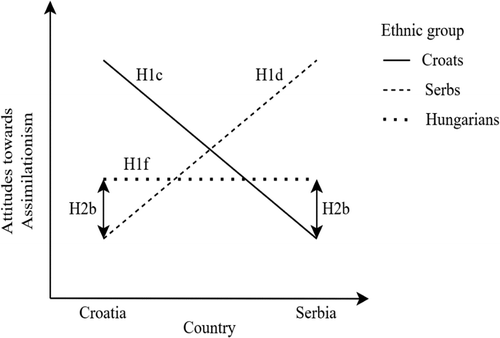
The same ethnic groups when in majority position will endorse multiculturalism less and assimilationism more than when in minority position (see Verkuyten & Yildiz, 2006). In other words, Croats in Croatia and Serbs in Serbia will endorse multiculturalism less (H1a for Croats and H1b for Serbs) and assimilationism more (H1c for Croats and H1d for Serbs) than Croats in Serbia and Serbs in Croatia. Since Hungarians are a minority in both countries, we expected no differences in endorsing multiculturalism (H1e) and assimilationism (H1f) among Hungarians in two countries.
Additionally, we hypothesized that
Formerly conflicted minorities who still face challenges of their new minority social status (i.e., Serbs in Croatia and Croats in Serbia) would differ from the group with a long-established position of being minority in both countries (i.e., Hungarians). Specifically, when in minority positions, Croats and Serbs will endorse multiculturalism more (H2a) and assimilationism less (H2b) than Hungarians.
We also wanted to expand understanding of mechanisms underlying the effect of ethnic group identification on the endorsement of multiculturalism andassimilationism. Following the self-categorization theory (Turner & Reynolds, 2001) and the GILM (Verkuyten, 2009), we tested a mediation model where ethnic identification is an antecedent of perceived outgroup symbolic threat and leads to the endorsement of multiculturalism and assimilationism indirectly, via its connection with the perceived outgroup threat. However, we propose that the ethnic group status (majority or minority) moderates the link between symbolic threat and multiculturalism/assimilationism as well as the link between ethnic group identification and multiculturalism/assimilationism (see Figure 3). We expected to replicate our models in Croatia, where Croats are the majority and Serbs and Hungarians are minorities, and in Serbia where Serbs are the majority and Croats and Hungarians are minorities. Additionally, we tested if the model will differ between two minorities in each country, i.e., if effects will be stronger for postconflict minority Serbs in Croatia and Croats in Serbia compared to the nonconflict Hungarians in both countries.
Hence, we hypothesize the following:

Higher ethnic group identification will be associated with lesser endorsement of multiculturalism in majority and higher endorsement of multiculturalism in minority groups both directly and indirectly via the perception of (greater) symbolic threat (see Figure 4).

Higher ethnic group identification will be associated with higher endorsement of assimilationism in majority and lesser endorsement of assimilationism in minority both directly and indirectly via perception of (greater) symbolic threat (see Figure 5).

Method
Sample and Procedure
We collected data in 2017 in Croatia and Serbia in multiethnic contexts where target minority children practice education in their mother tongue: the Croato–Serbian and the Croato–Hungarian contexts in Croatia and the Serbo–Croatian and the Serbo–Hungarian contexts in Serbia. To distinguish between contexts, we name them by following the rule of mentioning the name of the majority group first and the relevant minority second. For example, the Serbo–Croatian context is in Serbia (Serbs are majority and Croats are minority), but Croato–Serbian context is in Croatia (Croats are majority and Serbs are minority). The Ethics Committee of the Department of Psychology, University of Zagreb approved this study.
We recruited students from 19 schools in Croatia and 12 schools in Serbia. The questionnaires were administered in each group's mother tongue, during regular school hours. Participation was voluntary, and students completed questionnaires anonymously. We obtained parental permission for students under the age of 14.
In total, 1,367 students completed the questionnaire (48.2% male, 51.5% students from elementary school), 695 from Croatia and 672 from Serbia, with the age range from 11 to 19 years (M = 15; SD = 2.06). In the majority sample from Croatia, there were 419 students (60.3%). Of those, 356 (85%) were from Croato–Serbian context and assessed their attitudes toward their Serbian peers, and 63 (15%) were from Croato–Hungarian context and assessed their attitudes toward their Hungarian peers. In the minority samples from Croatia, there were 226 Serbs (32.5%) and 50 Hungarians (7.2%) who assessed their attitudes toward the majority Croats. In the majority sample from Serbia, there were 327 students (48.7%). Of those, 269 (82.3%) assessed their attitudes toward their Hungarian peers, and 58 (17.7%) assessed their attitudes toward their Croatian peers. In the minority samples from Serbia, there were 297 Hungarians (44.2%) and 48 Croats (7.1%) who assessed their attitudes toward the majority Serbs.
Instruments
All measures were substantially the same for all participants regardless of the country and group status; however, questionnaires were contextually adapted. Whereas minorities always assessed their attitudes toward majority students, majority students assessed their attitudes toward relevant minorities, depending on the context they live in (i.e. Croats in Vukovar-Sirmium County [the Croato–Serbian context] toward Serbs and Croats in Osijek-Baranja County [the Croato–Hungarian context] toward Hungarians). See the Appendix for survey questionnaire items.
Ethnic Identity Scale
Five items adapted from Doosje et al. (1995) assessed ethnic identification. Participants indicated their responses on a 5-point scale ranging from 1 = highly disagree to 5 = highly agree. Higher results indicated stronger ethnic identification. The reliability of the scale for the majority and minority subsamples in both countries was between α = .88 and α = .91.
Perceived Symbolic Threat
To assess the symbolic outgroup threat, we adapted a measure from Čorkalo Biruški (2011). Participants assessed their agreement with each of the five items on a 4-point scale ranging from 1 = highly disagree to 4 = highly agree. Higher results indicated stronger perception of intergroup symbolic threat. The reliability of the scale for the majority and minority subsamples in both countries was between α = .80 and α = .82.
Attitudes Toward Multiculturalism
Five items used in Čorkalo Biruški and Ajduković (2007) assessed attitudes toward multiculturalism. The items describe acceptance and appreciation of ethnic diversity. Participants indicated their responses on a 4-point scale ranging from 1 = highly disagree to 4 = highly agree. The reliability of the scale for the majority and minority subsamples in both countries was between α = .56 and α = .76. Higher results indicate more positive attitudes toward multiculturalism.
Attitudes Toward Assimilationism
Five items used in Čorkalo Biruški and Ajduković (2007) assessed attitudes toward assimilationism. The items describe superiority and dominance of the ethnic majority identity and culture. Participants indicated their responses on a 4-point scale ranging from 1 = highly disagree to 4 = highly agree. The reliability of the scale for the majority and minority subsamples in both countries was between α = .73 and α = .77. Higher results indicate more positive assimilationism attitudes.
Results
We report results in two sections. First, we analyzed the effects of country and group status on the attitudes toward multiculturalism and assimilationism. Second, we analyzed relationships between ethnic group identification and endorsement of multiculturalism and assimilationism via perception of symbolic threat. Table 1 provides an overview of the means and standard deviations for all variables, and correlations are presented in Table 2.


Attitudes Toward Multiculturalism and Assimilationism
To examine the effects of country and group status on the attitudes toward multiculturalism and assimilationism, we conducted two 2 (Croatia/Serbia) × 3 (Croatsmajority/minority, Serbsmajority/minority, Hungarians) univariate ANOVAs, for each of two dependent variable separately. Unless noted differently for all effects described as significant, p ≤ .001.
Attitudes Toward Multiculturalism
Figure 6 shows the interaction effect of a country and ethnic group on attitudes toward multiculturalism. The interaction predicted in hypothesis H1 was significant, F (2, 1,305) = 31.26, ηp2 = .05, and simple effects analyses showed that the effect of country was significant for both Croats (H1a), F (1, 1,305) = 12.06, ηp2 = .01, and Serbs (H1c), F (1, 1,305) = 94.60, ηp2 = .07, but not significant for the Hungarians (H1e). Thus, we confirmed that the same ethnic group when in majority position supported multiculturalism less than when in minority position (H1a and H1c). In line with the hypothesis H1e, we found no differences between Hungarians in Croatia and Serbia, since they are a minority group in both countries (see Table 1). Furthermore, Croats in Serbia held more positive multiculturalism attitudes than Hungarians in Serbia (H2a), F (2, 1,305) = 21.09, ηp2 = .03, although this effect size is rather small. Contrary to the hypothesis H2a, conflicting and nonconflicting minority groups in Croatia, Serbs, and Hungarians did not differ.

Attitudes Toward Assimilationism
Figure 7 shows the interaction effect of country and ethnic group on attitudes toward assimilationism. The interaction predicted in hypothesis H1 was significant, F (2, 1,297) = 75.98, ηp2 = .11, and simple effect analyses showed that the effect of country was significant for both Croats (H1b), F (1, 1,297) = 33.99, ηp2 = .03, and Serbs (H1d), F (1, 1,297) = 177.21, ηp2 = .12, but not significant for the Hungarians (H1f; see Table 1). Thus, we confirmed that the same ethnic group when in majority position had more positive assimilationist attitudes than when in minority position (H1b and H1d), and that Hungarians, a minority group in both countries, did not differ (H1f). In line with our hypothesis H2b, in both countries, two minority groups differed in their assimilationist view. Croats in Serbia held more negative attitudes toward assimilationism compared to Hungarians in Serbia, F (2, 1,297) = 32.98, ηp2 = .05. Similarly, Serbs in Croatia held more negative assimilationist attitudes than Hungarians in Croatia, F (2, 1,297) = 86.24, ηp2 = 12.
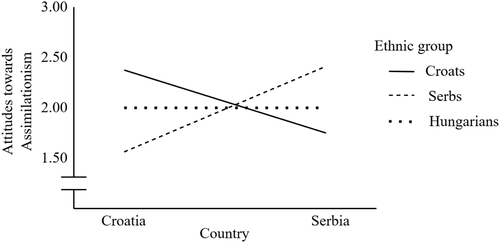
Moderated Mediation Analyses
To examine relations between ethnic group identification, perception of symbolic threat and attitudes toward multiculturalism and assimilationism, we tested direct and indirect effects in the proposed moderated mediation model using the PROCESS macro for IBM SPSS (Hayes, 2018). We tested four models on majority and minority in two countries. Before conducting analyses on a combined minority sample in each county, we tested to see if the minority ethnic group would moderate the proposed mediation model, i.e., would the model differ between different minorities. Because this moderation was not confirmed, we continued our analyses and focused our interpretation on a combined minority sample in each country. However, we call for caution because minority groups vary largely in size and have somewhat different status in their respective countries. To calculate confidence intervals for indirect effects, we used the bootstrap method, relying on 5,000 replacement samples. When percentile bootstrap confidence intervals exclude zero, we interpreted indirect effects as significant. PROCESS macro has no internal procedure for dealing with missing data other than listwise deletion so only complete data entered into analyses. This moderated mediation model is preprogrammed in PROCESS as model number 15. Two regression equations, one for M and one for Y specify it (also see Figure 8):

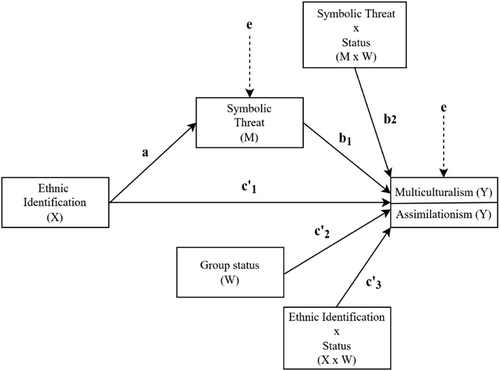
From these equations follows:

Multiculturalism as an Outcome
Overall, the model in Croatia (N = 604) explained 14% of the multiculturalism variance, R2= .14, F (5, 598) = 19.83, p < .001 (Table 3). The model in Serbia (N = 672) explained 9% of the multiculturalism variance, R2= .09, F (5, 666) = 13.70, p < .001 (Table 4).

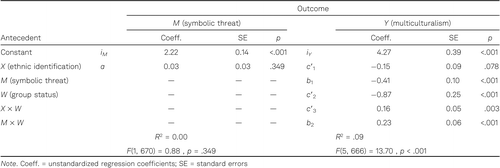
We partially confirmed the hypothesis about the direct effect of ethnic identification on multiculturalism (H3) and only in Serbia (Table 4, effect c′3). Analysis of the moderated direct effects of ethnic identification on multiculturalism, effect (c′3 + c′3W) from previous equation (3), showed the more minorities in Serbia were attached to their ethnic groups, the more they endorsed multiculturalism (coeff. = 0.16, CI [0.09, 0.22]). Contrary to our hypothesis, the effect of ethnic identification on multiculturalism was not significant among majority, i.e., Serbs in Serbia.
We partially confirmed the hypothesis about the indirect effect of ethnic identification on multiculturalism via perception of greater symbolic threat (H3) and only in Croatia (index of moderated mediation ab2 = 0.03, bootstrapped SE = 0.01, bootstrapped 95% CI [0.01, 0.06]). Analysis of the moderated indirect effects of ethnic identification on multiculturalism, effect a(b1 + b2W) from previous equation (4), showed that for the majority group, i.e., Croats, higher ethnic group identification was associated with lesser endorsement of multiculturalism via greater symbolic threat perception (coeff. = −0.02, CI [−0.04, −0.01]). Contrary to our hypothesis, this indirect effect was not significant among Serbian and Hungarian minorities in Croatia.
Assimilationism as an Outcome
Overall, the model in Croatia (N = 596) explained 27% of the assimilationism variance, R2= .27, F (5, 590) = 44.31, p < .001 (Table 5). The model in Serbia (N = 672) explained 12% of the assimilationism variance, R2= .12, F (5, 666) = 18.36, p < .001 (Table 6).
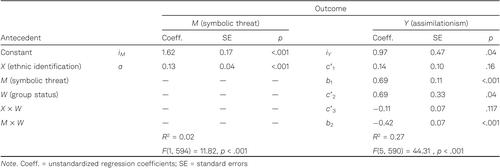
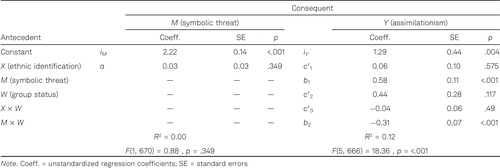
Contrary to the hypothesis about the direct effect of ethnic identification on assimilationism (H4), there was no significant ethnic identification by group status interaction neither in Croatia nor in Serbia (Tables 5 and 6, effect c′3).
We partially confirmed hypothesis about indirect effect of ethnic identification on assimilationism via perception of greater symbolic threat (H4) and only in Croatia (index of moderated mediation ab2 = −0.06, bootstrapped SE = 0.02, bootstrapped 95% CI [−0.10, −0.02]). Analysis of the moderated indirect effects of ethnic identification on assimilationism, effect a(b1+ b2W) from previous equation (4), showed that for the majority group, i.e., Croats, higher ethnic group identification was associated with higher endorsement of assimilationism via greater symbolic threat perception (coeff. = 0.04, CI [0.01, 0.06]). Contrary to our hypothesis, this indirect effect was not significant among Serbian and Hungarian minorities in Croatia.
Since we failed to replicate our models in Croatia and Serbia, we summarized our findings for each country separately.
In Croatia, we corroborated the mediation effect of symbolic threat on relation between ethnic identity and both multicultural and assimilationist attitudes but only for the majority. Group status did not moderate the direct effect of ethnic identification neither on multiculturalism nor on assimilationism.
In Serbia, we did not find evidence for mediation of symbolic threat on relation between ethnic identity and multiculturalism and assimilationism. However, group status moderated the direct effect of ethnic identification on multiculturalism, positive effect for minorities, and nonsignificant for majority.
Discussion
The aim of this study was to compare attitudes toward multiculturalism and assimilationism among complementing majority and minority groups in Serbia and Croatia and to examine the interrelation between ethnic identity, symbolic threat, and aforementioned attitudes. This study was conducted in multiethnic communities in Croatia and Serbia, focusing on relations between the majority and the two types of minorities in each country ‒ one new minority with a recent history of conflict with the majority (Serbs in Croatia and Croats in Serbia) and another more traditional minority with no recent conflict (Hungarians).
Attitudes Toward Multiculturalism and Assimilationism Among Three Ethnic Groups in Neighboring Countries
Our findings confirm that attitudes toward assimilationism and multiculturalism are largely determined by the group's status. Thus, by analyzing attitudes of two ethnic groups with different status in neighboring countries, we show that their ideological attitudes of multiculturalism and assimilationism are not a question of ethnicity or specific culture but rather of the current group status within a given society. Indeed, majority Croats in Croatia endorse assimilationism more and multiculturalism less than minority Croats in Serbia. The same holds for Serbs when in majority status in Serbia versus minority position in Croatia. Furthermore, we did not find differences in multiculturalism and assimilationism among Hungarians in Croatia and Serbia confirming the group status as the key determinant of these attitudes. This is in line with previous research (Čorkalo Biruški et al., 2020; Verkuyten, 2005). Thus, it seems that relationship between group status and endorsement of multiculturalism and assimilationism applies equally regardless whether minority group holds traditional minority position, as the present research shows, or is an immigrant minority, as previously corroborated with different immigrant groups (e.g., Arends-Tóth & van de Vijver, 2003; Berry & Kalin, 1995; Verkuyten & Martinovic, 2006; Verkuyten & Thijs, 2002). This suggests that majority–minority asymmetry in endorsing multiculturalism and assimilationism is rather universal phenomenon, regardless of a type of minority the majority is in interaction with.
However, group status is not the only determinant of assimilationism or multiculturalism attitudes, and we hypothesized that not all minorities are the same. Namely, we expected that in both countries, the formerly conflicted minorities who are still accommodating to their new social position of being minority (i.e., Serbs in Croatia and Croats in Serbia) would differ from the long-established Hungarian minority. We confirmed that different minorities differed in all cases except one: Serbs and Hungarians in Croatia endorse multiculturalism equally, but Serbs as a new minority held even more negative attitudes toward assimilationism than Hungarians did. In Serbia, new minority Croats supported multiculturalism more and assimilationism less than Hungarians did.
Interrelation Between Ethnic Identity, Symbolic Threat, and Attitudes Toward Multiculturalism and Assimilationism
Generally, our study confirmed group status as an important predictor of multiculturalism and assimilationism. Yet, the mechanism by which this is accomplished has not been clearly demonstrated. Specifically, we hypothesized that for majority groups, stronger ethnic group identification will be associated with lesser endorsement of multiculturalism (and higher endorsement for minority groups) both directly and indirectly via perception of (higher) symbolic threat. We hypothesized the opposite for assimilationism. However, our data have not confirmed that symbolic intergroup threat is a key mediating mechanism, but rather show important country (i.e., contextual) particularities.
Our findings showed that the threat mediates the relationship between ethnic identification and assimilationism and multiculturalism only for majority Croats in Croatia. It is possible that the perception of threat has a more prominent social function in Croatia compared to Serbia due to recent war circumstances in Croatia and interethnic tensions between Croats and Serbs over the process of postconflict recovery. Although the key mediating role of symbolic threat has not been confirmed consistently across the contexts, our data showed important contextual differences in symbolic threat in two countries: Perceived symbolic threat is actually higher for Serbs in Croatia than for Croats in Serbia. Conversely, Hungarians as the minority in both contexts feel more threatened in Serbia than in Croatia. It seems that the history of the recent conflict in Croatia is the major determinant of the perception of the conflicting minority threat.
Nevertheless, differences in the perceived symbolic threat may be also due to minority group size in a specific context. For example, Serbs are the largest national minority in Croatia and especially in the city of Vukovar (33%) where most of our respondents come from, whereas Croats are a very small minority in Serbia (less than 1% in Serbia and less than 2.5% in Vojvodina where we conducted our study). Thus, it is plausible that, although minority Croats cherish their identity, they are not perceived as a real threat to the Serbian majority. Conversely, Serbs as the largest minority in Croatia, struggling for ways to preserve their identity, might represent a much stronger (symbolic) threat to the majority but also feel more threatened by it. Indeed, it has been shown that perceived intergroup threat is more pronounced for larger minority groups (McLaren, 2003; Stephan et al., 2009). We turn to minority Hungarians' results for support of this explanation: In Serbia, where Hungarians are the largest minority group (13%), they perceive more symbolic threat to their identity than in Croatia where Hungarians are far less numerous (less than 3%).
Future Directions
Our comparisons of two different minority groups within the same context showed the importance of a specific majority–minority context within a given society (cf. Staerklé et al., 2010). Hence, we believe that more extreme results of new minorities in both Croatia and Serbia reflect the struggle of new minorities for their equal status within particular society but also probably the ongoing tensions between Croats and Serbs that are present as the legacy of the 1991–1995 war (e.g., Spini et al., 2014). To test this assumption, we call for studies to be conducted in social settings that went through similar processes of profound social change, e.g., in many countries (re)established after the fall of communism. Another possibility is that the obtained contextual difference is a consequence of the duration of the group’s minority status. While Hungarians in Croatia and Serbia are long-established minorities, Serbs in Croatia and Croats in Serbia are new minorities, who struggle with their identity formation and affirmation (e.g., Phinney, 1992). For them, stronger rejection of assimilationism and stronger endorsement of multiculturalism may serve as an ideological buffer in preserving their group identity and their social status. Hence, when studying minority groups, specific social context should be considered before assuming typicality of social patterns of minority groups.
Furthermore, we did confirm the key role of group status in determining endorsement of multiculturalism and assimilationism in multiethnic contexts where minorities are not newly arrived but are traditionally present in the society, though experienced a substantial change in their social status due to more general political changes. Hence, this finding consolidates further our knowledge on majority–minority dynamics in multiethnic settings. On the contrary, the finding that the mediating role of threat in the relationship between ethnic identity and diversity ideologies of multiculturalism and assimilationism has been confirmed only for Croat majority is puzzling and needs further research. Therefore, future studies might benefit from extending the sample on more minority groups that differ in several aspects – group size, history of conflict, the level of interethnic tension, and group’s social status within a society. Furthermore, having in mind that our variables accounted for only 27% of variance of endorsement of assimilationism in Croatia and 12% in Serbia and somewhat less for multiculturalism (14% in Croatia and 9% in Serbia), future studies need to look for other possible mechanisms besides symbolic threat that might be at work and that could explain differences between the countries. Although we departed from the intergroup threat theory framework (Stephan et al., 2009), we did not measure realistic threat or intergroup anxiety, which should be investigated in addition to symbolic threat in future studies. Finally, it is also possible that social norms regarding multiculturalism as a desirable strategy for managing diversity differ in different contexts so the role of community norms should also be explored.
References
(2001). General and acculturation-related daily hassles and psychological adjustment in first-and second-generation South Asian immigrants to Canada. International Journal of Psychology, 36(3), 163–173. 10.1080/741930008
(2003). Multiculturalism and acculturation: Views of Dutch and Turkish–Dutch. European Journal of Social Psychology, 33(2), 249–266. 10.1002/ejsp.143
(1995). Multicultural and ethnic attitudes in Canada: An overview of the 1991 national survey. Canadian Journal of Behavioural Science, 27(3), 301–320. 10.1037/0008-400X.27.3.301
(2019). Contact, perceived threat, and attitudes toward assimilation and multiculturalism: Evidence from a majority and minority perspective in Luxembourg. Journal of Cross-Cultural Psychology, 50(2), 285–310. 10.1177/0022022118817656
(2011). Djeca i međuetnički odnosi u zajednici [
Children and interethnic relations in the community ]. [Unpublished project documentation]. Faculty of Humanities and Social Sciences, University of Zagreb.(2022). Integration processes of majority and minorities in ethnically mixed communities. 10.23669/EEN9PN/UC6ACW
(2007). Separate schools – a divided community: The role of the school in post-war social reconstruction. Review of Psychology, 14(2), 93–108.https://hrcak.srce.hr/25575
(2020). Obrazovni izbori i stavovi prema multikulturalizmu i asimilacionizmu većine i manjine u četiri višeetničke zajednice [Educational choices and attitudes towards multiculturalism and assimilationism of the majority and minorities in four Croatian multiethnic communities]. Društvena istraživanja, 29(1), 23–47. 10.5559/di.29.1.02
(2008). Colorblind and multicultural prejudice reduction strategies in high-conflict situations. Group Processes & Intergroup Relations, 11(4), 471–491. 10.1177/1368430208095401
(1995). Perceived intragroup variability as a function of group status and identification. Journal of Experimental and Social Psychology, 31(5), 410–436. 10.1006/jesp.1995.1018
(2018). Introduction to mediation, moderation, and conditional process analysis: A regression-based approach (2nd ed.). Guilford Publications.
(2012). Group status drives majority and minority integration preferences. Psychological Science, 23(1), 46–52. 10.1177/0956797611423547
(2014). Ideological attitudes of majority groups in two multiethnic environments. Revija za socijalnu politiku, 21(1), 19–41. 10.3935/rsp.v21i1.1149.
(1995). Multicultural citizenship: A liberal theory of minority rights. Clarendon Press.
(2020). On melting pots and salad bowls: A meta-analysis of the effects of identity-blind and identity-conscious diversity ideologies. Journal of Applied Psychology, 105(5), 453. 10.1037/apl0000446
(2014). Provjera postavki teorije međugrupne prijetnje u višeetničkoj zajednici nakon sukoba [
Testing the intergroup threat theory in a multiethnic community after a severe conflict ]. Doctoral dissertation, University of Zagreb. Faculty of Humanities and Social Sciences Institutional Repository. http://darhiv.ffzg.unizg.hr/id/eprint/9184/.(2003). Anti-immigrant prejudice in Europe: Contact, threat perception, and preferences for the exclusion of migrants. Social Forces, 81(3), 909–936. 10.1353/sof.2003.0038
(2005). National minority education in Croatia. In N. Genov (Ed.), Ethnicity and educational policies in South Eastern Europe (pp. 64–78). Lit Verlag.
(1993). Social psychology in cross-cultural perspective. Freeman.
(2017). The role of assimilation and multiculturalism for the relation between social dominance orientation and prejudice: The case of Anglophones and Francophones in Québec. Journal of Cross-Cultural Psychology, 48(6), 874–891. 10.1177/0022022117706414
(1992). The multigroup ethnic identity measure: A new scale for use with diverse groups. Journal of Adolescent Research, 7(2), 156–176. 10.1177/074355489272003
(2013). Diversity ideologies and intergroup relations: An examination of colorblindness and multiculturalism. European Journal of Social Psychology, 43(1), 12–21. 10.1002/ejsp.1892
(2006). Intergroup threat and outgroup attitudes: A meta-analytic review. Personality and Social Psychology Review, 10(4), 336–353. 10.1207/s15327957pspr1004_4
(2008). The concept of multiculturalism: A study among Dutch majority members. Journal of Applied Social Psychology, 38(8), 2152–2178. 10.1111/j.1559-1816.2008.00385.x
(2013). Cultural values and group-related attitudes: A comparison of individuals with and without migration background across 24 countries. Journal of Cross-Cultural Psychology, 44(2), 245–262. 10.1177/0022022112444898
(2013). Is multiculturalism a viable path in Chile? Intergroup and acculturative perspectives on Chilean society and Peruvian immigrants. International Journal of Intercultural Relations, 37(6), 739–749. 10.1016/j.ijintrel.2013.09.011
Spini, D.Elcheroth, D.Čorkalo Biruški, D. (Eds.), (2014) War, community, and social change: Collective experiences in the former Yugoslavia. Springer.
(2010). Ethnic minority-majority asymmetry in national attitudes around the world: A multilevel analysis. Political Psychology, 31(4), 491–519. 10.1111/j.1467-9221.2010.00766.x
(2009). Intergroup threat theory. In T. D. Nelson (Ed.), Handbook of prejudice, stereotyping, and discrimination (pp. 43–59). Lawrence Erlbaum Associates.
(1986). The social identity theory of intergroup behavior. In S. WorchelW. G. Austin (Eds.), Psychology of intergroup relations (pp. 7–24). Nelson-Hall Publishers.
(2012). Is support for multiculturalism threatened by threat itself?. International Journal of Intercultural Relations, 36(1), 22–30. 10.1016/j.ijintrel.2010.09.011.
(2001). The social identity perspective in intergroup relations: Theories, themes and controversies. In R. BrownS. L. Gaertner (Eds.), Handbook of social psychology: Intergroup processes (Vol. 4, pp. 133–152). Blackwell.
(1998). Attitudes of minority and majority members towards adaptation of immigrants. European Journal of Social Psychology, 28(6), 995–1013. 10.1002/(SICI)1099-0992(1998110)28:6<995::AID-EJSP908>3.0.CO;2-8
(2005). Ethnic group identification and group evaluation among minority and majority groups: Testing the multiculturalism hypothesis. Journal of Personality and Social Psychology, 88(1), 121–138. 10.1037/0022-3514.88.1.121
(2011). Assimilation ideology and outgroup attitudes among ethnic majority members. Group Processes & Intergroup Relations, 14(6), 789–806. 10.1177/1368430211398506
(2022). Right-wing political orientation, national identification and the acceptance of immigrants and minorities. Personality and Individual Differences, 184, 111217. 10.1016/j.paid.2021.111217
(2006). Understanding multicultural attitudes: The role of group status, identification, friendships, and justifying ideologies. International Journal of Intercultural Relations, 30(1), 1–18. 10.1016/j.ijintrel.2005.05.015
(2006). Multicultural recognition and ethnic minority rights: A social identity perspective. European Review of Social Psychology, 17(1), 148–184. 10.1080/10463280600937418
(2009). Support for multiculturalism and minority rights: The role of national identification and out-group threat. Social Justice Research, 22(1), 31–52. 10.1007/s11211-008-0087-7
(2002). Multiculturalism among minority and majority adolescents in the Netherlands. International Journal of Intercultural Relations, 26(1), 91–108. 10.1016/S0147-1767(01)00039-6
(2006). The endorsement of minority rights: The role of group position, national context, and ideological beliefs. Political Psychology, 27(4), 527–548. 10.1111/j.1467-9221.2006.00525.x
(2006). An integrative model of attitudes toward immigrants. International Journal of Intercultural Relations, 30(6), 671–682. 10.1016/j.ijintrel.2006.06.002
(2010). The role of cultural inertia in reactions to immigration on the U.S./Mexico border. Journal of Social Issues, 66(1), 45–57. 10.1111/j.1540-4560.2009.01632.x
Appendix
Survey Questionnaire Items
Ethnic Identity Scale
A 5-point Likert-type scale ranging from 1 = highly disagree to 5 = highly agree.
- 1.I am glad to be a member of my nation.
- 2.I feel strong ties with members of my nation
- 3.Belonging to my nation is very important to me.
- 4.I feel that I belong to my nation.
- 5.Belonging to my nation makes me proud.
Perceived Symbolic Threat Scale Items
A 4-point scale ranging from 1 = highly disagree to 4 = highly agree.
- 1.My [out-group] peers do not respect the language of my nation.
- 2.My [out-group] peers should not overemphasize their national symbols and customs.
- 3.My [out-group] peers are listening the music that bothers us.
- 4.My [out-group] peers think they are better than we are.
- 5.My [out-group] peers are name-calling us because we are of different nationality.
Attitudes Toward Multiculturalism
A 4-point scale ranging from 1 = highly disagree to 4 = highly agree.
- 1.National minorities enrich the culture of every nation.
- 2.It is important that members of the majority also know the customs and traditions of the minorities with whom they live.
- 3.Every country is obliged to take care of the rights of national minorities.
- 4.The school should teach about democracy and human rights.
- 5.It is good that members of national minorities can be schooled in their own language.
Attitudes Toward Assimilationism
A 4-point scale ranging from 1 = highly disagree to 4 = highly agree.
- 1.All children should go to schools in the Croatian [Serbian] language, without any special features for minority groups.
- 2.Majority nation should dictate how education of the county looks like.
- 3.Members of national minorities should socialize more with Croats [Serbs] than with members of their own nation in order for them to fit better into Croatian [Serbian] society.
- 4.It is more important for national minorities to learn Croatian [Serbian] well than their mother tongue.
- 5.It is more important for national minorities to adopt the traditions and customs of Croatian [Serbian] culture than the traditions and customs of their nation.



